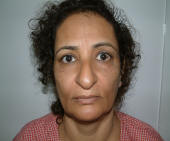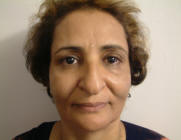|
CHEEKS
WHAT IS NORMAL?
- From the front view the cheeks should bulge to the side about one finger breadth.
- From the side the cheek should form a distinct peak in front and below the eye.
- Both cheeks and the chin should form a balanced triangle with roundness and definition.
COMMENT: Since the cheek is a three dimensional enlargement, it is perhaps the hardest to define normal. Although routinely Caucasians want cheek enhancement, Orientals may consider the cheek bones too pronounced.
SELF-EVALUATION:
- A frontal photo may be helpful.
- Pull out on the cheek skin at the crest. Is that a look you like?
- At the doctor's consultation, he may inject some saline into the tissues to give you an impression of the enhanced look.
- Is it hollow below your cheek bones?
HOW MUCH CAN BE IMPROVED?
-
Cheek implants come in all shapes and sizes. We encourage patients to go for a balanced look. There is a tendency of people to choose to overcompensate and again look unnatural. Sometimes, more is not better. Don't feel like because you've paid for it you want to see a big difference. Instead go for a natural result!
-
If it is hollow below the cheek bone, special implants may help fill this region. Be sure to ask your doctor.
Custom implants are available
-
Small asymmetries may be impossible to correct. If your cheek bones are different sizes in the first place, the implants my look uneven after. Implants can also rotate and displace small amounts.
-
Implants may go below the cheek bone to help fill in the hollow area. They must reach up to the bone.
THE OPTIONS: CHEEKS
Until recently, surgery of the cheeks, simply involved increasing the size by implants. The numbers and types of implants were limited in size and design. Several things have changed. For one, the variations and designs of implants have increased the possible configurations tremendously.
HOW ARE CHEEK IMPLANTS PLACED?
The procedure is technically simple. It involves freezing up the cheek area and usually making an incision inside of the mouth in the area of the cheek bone, separating the surrounding tissues around the bone, and placing the implant in the pocket.
Some doctors will place the cheek implant in a lower eyelid incision, or during a facelift they can conveniently be placed using the routine facelift incision.
HOW BIG DO I WANT MY CHEEK IMPLANTS?
As a patient, there is a natural tendency to ask the surgeon for the biggest thing your money can buy. In the area of cheek implants, this can be a dangerous tendency. If a person is trying to achieve a natural look, sometimes only small implants are necessary to bring the face into balance.
ARE CHEEK IMPLANTS DANGEROUS?
Unlike the controversy surrounding liquid silicone, solid silastic used in cheek implants does not leak into the tissues in any significant way. Since the implant basically rests on the bone, there is no real possibility of migration (the implant moving). A fairly small scar capsule does form around the silastic implant, but this has never been shown to be detrimental. The same is true for chin implants.
MALAR VERSUS SUBMALAR IMPLANTS
In the past five years, it was noted that when the cheek implants slip below the cheek bones, the appearance was improved in some patients. The implant then filled out the hollow below the cheekbone, which can be a sign of aging as the base thins.
To capitalize on this observation, a set of implants were developed that goes below the cheekbone. Also, large implants have been designed that cover both the cheekbones and the SUBMALAR area, below the cheeks.
Routine cheek implants go directly over the cheek bones also known as the malar bone. These lower cheek implants are therefore called SUBMALAR.
Unfortunately, these implants have been misrepresented as a quick replacement for a face lift and really do no such thing. Although they may help balloon out a sagging cheek, they have very little affect on the other areas of the face once the swelling has gone down from the surgery.
There are also some large implants that enlarge the entire cheek area, both over the cheek bone itself and in the hollow below the cheek. Select patients who want this type of look may be appropriate for this implant.
  FAT REMOVAL FROM THE CHEEKS
Some people feel that they have "pudgy" cheeks and fat removal from this area has become a common procedure. This can add some definition to the cheek region.
It is a relatively safe procedure in which a small incision is made inside the mouth and a small wad of fat is removed.
The major concern with this procedure is that in later years, when this fat tends to be lost away, this will leave the patient with an unnaturally gaunt look.
CHEEK IMPLANT COMPLICATIONS
- ASYMMETRY/DISPLACEMENT
A small amount of asymmetry as common with cheek implants. If your cheeks were asymmetric underneath, the implants will also be uneven. Since the implants are not sewn down, they may rotate a small amount in one direction or another.
Your surgeon may be able to adjust them, but they may never end up exactly symmetric.
- NUMBNESS
The nerve that carries sensation to the cheek is between the nose and the cheek and may be bruised when the implant is placed. Traditionally, this will improve with time but it may take months. No treatment will help it.
- INFECTION
Implants placed through the mouth may become infected and need to be removed temporarily.
|